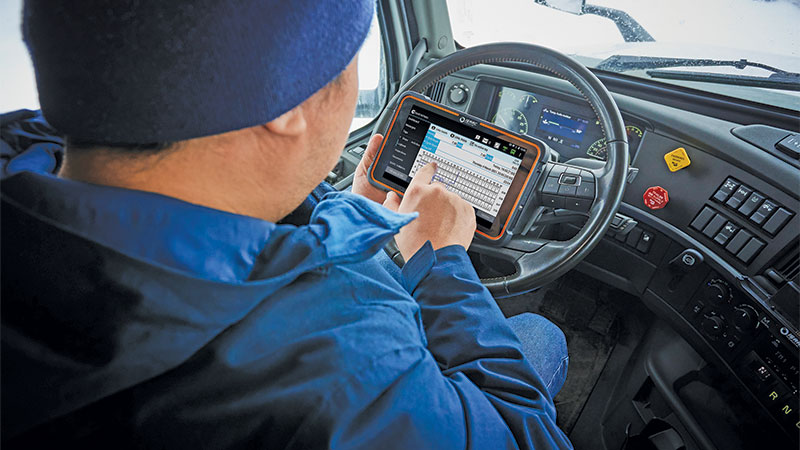Sonja Houston, Business Development Manager at ISAAC Instruments
Canadian ELDs remain the topic of the hour. After all, these mission-critical electronic devices will be at the heart of operations for carriers travelling in Canada. In the previous article, we ran through an A-to-Z checklist of the steps to include in an implementation plan. Let’s now dive into one critical item on that list, one whose importance cannot be overstated. You guessed it: communication.
What to Communicate and When
Everyone agrees about the importance of communication, but the concept can be somewhat abstract and mean different things to different people.
Training first comes to mind when we think of communication in the context of implementing technology. It is indeed at the heart of a change such as the coming of Canadian ELDs; however, keeping communication channels open with your team, prior to and after training occurs, will be helpful.
Announcing that a change is coming, before the training is even organized, doesn’t require detailed information. Provide the information you have; making high-level official enforcement dates known and the months when training is planned can be sufficient. This gets everyone in the loop early on in the process and helps them get into the change mindset.
Post-training resources are of the utmost importance because it is often after the training that questions arise in the minds of users. When your team is in the field and using the new technology is when real-life happens and support is required.
Communication is an ongoing process that involves training users, keeping everyone informed of upcoming organizational changes, and providing continued support after the fact.
Leaving No One Out
Drivers are at the heart of the Canadian ELD transition and will no doubt be central in the process. However, the drivers’ ‘extended family’ – those who work around them to provide support – must also be considered when preparing for these changes.
ISAAC’s Compliance & Safety Specialist Melanie Simard has over 20 years of experience in the trucking industry as a driver, dispatcher and safety manager. She stresses the importance of taking a step back to target possible impacts for not only dispatchers and compliance officers, but also for those involved with truck maintenance.
Manon L’Espérance, who has supported truck fleet operations for over 20 years at top Canadian fleet Groupe Robert is of the same opinion. Now as a Product Manager at ISAAC, she is keen on ensuring the documentation provided to carriers highlights some operational impacts of implementing a new technology. “Having end users learn the features of the ELD device is part of the training, but equally important is making the wider team aware of the operational impacts that result,” she cautions.
A Mile in Everyone’s Shoes
Visualizing a typical day of the entire team involved in operations can help understand and prepare for both the user experience of Canadian ELDs and the potential operational impacts. The changes will depend on whether you were previously using paper logs or an electronic device that may or may not have been compliant to U.S. ELD regulations.
The Driver’s Seat
Imagine drivers interacting with their ELD device during a shift. Besides their direct use of it, pay some thought to what may not be immediately apparent but crucial for them to understand. For example, the device will automatically report driving on their log if they travel above 8 km/hr. So, when driving in a yard, they’ll need to activate the yard move mode to avoid undue driving hours being logged.
Also, try to anticipate what might come as a surprise to drivers and result in time-consuming phone calls to the office for an explanation. For example: a message on their tablet, saying they need to approve a change to their logbook. Explain that ELD regulations are geared towards giving them full control of their daily log; therefore, they must approve any changes made by anyone but themselves.
In the event they need assistance in operating the ELD during their shift, explain how to get it fast – and in such a way that avoids a chain of phone calls, trying to connect with the right person to help them. Manon L’Espérance has worked to alleviate this kind of problem at Groupe Robert by setting up a help network to support drivers efficiently. “We too often forget that for drivers, every minute spent troubleshooting a problem instead of driving has a direct impact on their paycheck,” she insists. “We must be respectful of this reality and avoid as many lost minutes as we can.”
Dispatchers and Driver Managers
Dispatchers and driver managers often provide first-level support to drivers and will benefit from following the same training. Chances are they will assist drivers in making log adjustments. For example, leaving the driver with only the final task of approving the change. However, when this is not possible – because dealing with a log that is not signed – drivers must make the change themselves on their device inside the cab. The dispatcher may have to walk them through it if the driver is not sure on how to proceed. This is when remote assistance capabilities, that allow accessing the driver’s tablet from a distance, are extremely helpful. Hopefully, the system you are using will allow for it.
Melanie Simard has enjoyed the pluses of remote access capabilities for supporting drivers. “At Energy, it served not only for providing ad hoc assistance but also for remote training when drivers could not attend training on-site,” says Melanie. “In fact, in-cab training right before starting a shift often works better for drivers because they apply what they learn immediately.”
Manon L’Espérance, in her years spent supporting drivers at Groupe Robert, has referred to the remote assistance feature on their system as the ‘8th world wonder.’ “Being able to see the driver’s tablet screen right on your office computer and take control to help out, has saved us countless hours and relieved stress for our drivers,” she adds.
Compliance Managers
From the standpoint of those that ensure compliance in your fleet, stop to think of any changes Canadian ELDs might bring. Although they’re not first-hand users of the devices, think of the indirect impacts that may stem from the transition period drivers will be going through. If compliance keepers are the ones watching unassigned driving hours, they will be handling these records and have to wait for the approval of drivers they assign these hours to.
You might even choose to involve your compliance manager in preparing drivers for using the new system efficiently. Although hours of service regulations remain the same, Canadian ELD regulations influence how hours of service get recorded. For example, a driver that fails to immediately confirm that he or she is no longer driving after setting the parking brake will end up with added driving time. If unaware of this, drivers will be confused as to why their remaining driving hours are shorter than they’re expecting and could be sounding an alarm to the compliance team about the ELD ‘not working.’
Mechanical Shop
Does bringing the team who handles truck maintenance into the discussion seem far-fetched? During the transition to U.S. ELDs in 2019, Melanie Simard saw many calls come in following truck repairs while she worked at Energy Transportation Group. Mechanics who drove trucks into the shop at over 8 km/hr generated unassigned driving records, which should have been tagged as yard moves. So being thorough means training anyone who can potentially move the truck.
Your ELD Provideras a Partner in Change
Your ELD provider, while not an official regulations expert, was required to gain an in-depth understanding of Canadian ELD regulations in order to provide you with a compliant, third-party certified solution; therefore, they should be a good source of information to complement your communication efforts. See if they can provide documentation that lays out the before and after Canadian ELD scenarios; ideally concise, easy-to-follow cheat sheets that sum up what the members of your team must pay attention to.
Conclusion
Communication, communication, communication; this word often shows up in threes for a reason (a Google search on that string returns millions of hits). It has the power to change the face of your transition to Canadian ELDs;s to either make it a smooth experience or get you off to a rockier start than you’ve bargained for. To put every chance of success on your side, communicate early on, throughout, and after the implementation process. Leave no one out and play the ‘a-day-in-the-life-of’ game.


 1-866-985-9791
1-866-985-9791



